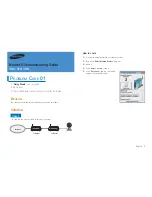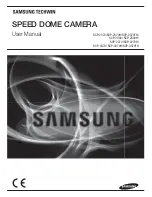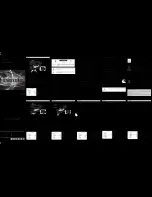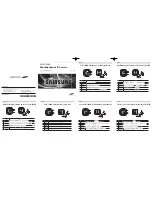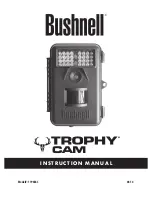
Step4 Adjustment
IMPORTANT:
● Check that the water-proof rubber installed in
the slot around the camera does not slide out
of the slot, and then mount the enclosure.
● Securely tighten all the enclosure fixing
screws (×4) of enclosure. Otherwise, the
enclosure dropping may result in injury.
(Recommended tightening torque: 0.59 N·m
{0.44 lbf·ft})
● After complete installation, remove the cover
film from the dome cover.
● Defocus may be caused by the reinstalled
enclosure. In this case, perform the auto focus
function from the setup menu.
Ⓔ
MONITOR OUT conversion plug (accessory)
Note:
● Depending on the lens range or the optical zoom, it must be noted that the shadow
of the enclosure may be projected.
● When the vertical (TILT) angle of the camera is more than 75°, part of image may
appear to be overlapped. To prevent from overlapping, reduce the vertical (TILT)
angle or adjust the optical zoom.
● When mounting the camera on a wall, rotate the pan table by 180° to the left and
rotate the tilt table till the TOP mark above the lens always comes to the top side.
● When adjusting the mounting to the ceilings, the enclosure and installed auxiliary
wire may be displayed on the screen depending on the direction the camera is fac-
ing. Move the enclosure and installation auxiliary wire so that they are not displayed
on the screen.
● To remove the SD memory card, hold down the SD ON/OFF button (about 2 seconds).
When the flashing SD MOUNT indicator goes out, you can remove the SD memory card.
● After the SD memory card has been replaced, press the SD ON/OFF button (less than 1
second), and make sure the SD MOUNT indicator is continually lit.
● If you do not press the SD ON/OFF button after replacing the SD memory card, the SD
MOUNT indicator is automatically lit approximately 5 minutes later.
Ⓗ
Bit
(accessory)
Installation
Step2 Fixing the brackets
Step1 Preparations
The installation tasks are explained using 4 steps.
There are 4 methods to install the camera to a ceiling or wall as described below. Prepare the
required parts for each installation method before starting the installation. The following are the
requirements for the various installation methods.
Installation method
Recommended
screw
Minimum pull-out
strength (per 1 pc.)
[1] Mount the camera on the two-gang junction box
using the
Ⓐ
attachment plate (accessory).
M4 screws × 4
196 N {44 lbf}
[2] Directly mount the camera onto the ceiling or
wall using the attachment plate (when wiring
can be installed in the ceiling or wall).
M4 screws × 4
196 N {44 lbf}
[3] Mount the camera onto the ceiling or wall
using the
Ⓑ
base bracket (accessory) (when
conduits are used for wiring, or when there is
no space available for wiring in the ceiling or
the wall).*
1
M4 screws × 4
196 N {44 lbf}
[4] Mount the camera on the ceiling using the WV-
Q105A ceiling mount brackets (when mounting
in areas where the screws are too weak to
support the total weight, such as the plaster
board of double-ceilings).
anchor bolts × 2
*
2
*1 Use 4 screws (M4 × 8 mm, accessory) to fix the attachment plate to the base bracket.
*2
Make sure that the installed ceiling can support more than 5 times of the weight of the cam-
era, the attachment plate and the anchor bolt.
When using [4] the WV-Q105A ceiling mount
brackets, use them indoors.
IMPORTANT:
● Procure 4 screws (M4) to secure the
Ⓐ
attachment plate (accessory) or
Ⓑ
base
bracket (accessory) to a ceiling or a wall.
● The minimum required pull-out capacity of a single screw or anchor bolt is 196 N
{44 lbf} or more when mounting with the installation method [1] to [3] above.
● When mounting the camera on a concrete ceiling, use an AY plug bolt (M4) for
securing. (Recommended tightening torque: 1.6 N·m {1.18 lbf·ft})
● Select screws according to the material of the ceiling or wall that the camera will be
mounted to. In this case, wood screws and nails should not be used.
● If a ceiling board such as plaster board is too weak to support the total weight, the
area shall be sufficiently reinforced.
[1] Using a two-gang junction box
[2] Directly mount the camera to the ceiling or wall using the attachment plate
[3] Mount the camera to a ceiling or a wall using
Ⓑ
base bracket
(accessory)
< When using the conduit on the ceiling
or wall for wiring>
The base bracket can be fixed in any of the following 6 screwing positions
according to ceiling and wall conditions. Match the hole used when
installing the camera to any of positions A to F.
<Mounting the base bracket>
q
Remove the cap for the female thread for
the conduit by using a hexagon wrench
(ISO 2936, width across flats S=5 mm
{3/16 inches}).
w
Mount the attachment plate and
the base bracket.
Ⓐ
Attachment plate (accessory)
Fixing screws for attach-
ment plate: ×4 (M4, locally
procured)
Ø25.4 mm
*1
{1 inch}
46 mm {1-13/16 inches}
Two-gang junction box
Ⓐ
Attachment plate (accessory)
Fixing screws for attachment plate: ×4 (M4, locally procured)
83.5 mm {3-9/32 inches}
Ø73 mm
*2
{2-7/8 inches}
*3 The wiring hole diameter is 25.4 mm {1 inch}. Select any of the 2 base bracket fixture holes of
Ⓖ
template B (accessory) when installing the base bracket. After mounting the attachment plate, the
mounting direction of the camera can be adjusted in 90° increments.
*4 When attaching the base bracket to a one-gang junction box in Position E, secure the base bracket
with 2 screws (M4, locally procured).
IMPORTANT:
● If open wiring is conducted, be sure to use conduits and run the cables inside
the tubes to protect the cables from direct sunlight.
● Installation work shall be such that there is no exposure to water into the
architecture through the conduits having been joined.
Step1
Preparations
Step2
Fixing the brackets
Step3
Mount the camera to the attachment
plate
Step4
Adjustment
FRONT
Cap for the female
thread for the
conduit
Ⓑ
Base bracket (accessory)
Fixing screws (M4 × 4, locally
procured)
Minimum pull-out
strength: 196 N {44.06 lbf}
(per 1 pc.)
Ⓒ
Fixing screws for
attachment plate: ×4
(accessory)
(Recommended tightening
torque: 0.78 N·m {0.58 lbf·ft})
Ⓐ
Attachment plate
(accessory)
*1
If the mounting direction of the camera has already been determined
Align the FRONT direction (the direction of FRONT marker on the camera that indicates the
installation direction when installing the camera) of
Ⓕ
template A (accessory) with the desired
direction, and drill through a 25.4 mm {1 inch} diameter hole.
*2
If the mounting direction of the camera is not determined yet or if you want to change
the direction of the camera after it has been installed
If you want to be able to change the direction of the camera, drill through a 73 mm {2-7/8 inch-
es} diameter hole in the center. By doing so you can adjust the mounting direction of the camera
in 90° increments.
Step3 Mount the camera to the attachment plate
q
Check the position of attachment
mounting screws on the rear side of
the camera.
w
Connect cables to the camera according to the
instructions in “Making connections”, and mount
the camera by inserting the attachment mounting
screws into the holes of the
Ⓐ
attachment plate
(accessory).
e
Loosen 4 enclosure fixing screws using the
Ⓗ
bit (accessory), and remove the enclosure
from the camera.
t
Loosen the cross-head side of tilt table fixing
screw (on one side), and incline the tilt table
while keeping the TOP mark on the camera
lens head facing the front (i.e. the direction of
FRONT mark on the camera).
y
Press the PUSH mark on both sides of the
inner cover at the same time, and remove
the inner cover as shown in the following
illustration.
Note:
:
● After cables have been connected to the camera, align the OPEN mark of the enclosure side panel with the protruding part of base
bracket, insert 2 attachment mounting screws into the attachment plate, and rotate the camera approximately 15°. The LOCK mark is
moved to the protruding part of base bracket and the camera is temporarily secured. (When directly attaching the attachment plate to a
ceiling or wall, align the OPEN mark to the tab position of the attachment plate.)
IMPORTANT:
● Be sure to tighten the camera fixing
screw. Failure to observe this may
cause camera trouble due to camera
falling. Recommended tightening
torque: 0.78 N·m {0.58 lbf·ft}
IMPORTANT:
● Disconnect the 12 V DC power source and PoE power source to prevent power from being supplied during mounting work.
● Enclosure is fixed to the camera body by the installed auxiliary wire, so please do not remove it.
● For installations on the wall, to prevent water from accumulating on the surface of the dehumidifying device, install the camera so that the
dehumidifying device does not face up. If water accumulates on the surface of the dehumidifying device, it cannot function properly.
< When drilling a hole through the
ceiling or wall for wiring>
● The female thread for conduit is compliant
with ANSI NPSM (parallel pipe threads) 3/4
or ISO 228-1 (parallel pipe threads) G3/4.
*
4
Tab position
of the attach-
ment plate
(×4)
Conduit
46 mm
{1-13/16 inches}
83.5 mm
{3-9/32 inches}
Position A
85 mm {3-11/32 inches}
(85.7 mm {3-3/8 inches})
138 mm
{5-7/16 inches}
46 mm
{1-13/16 inches}
138 mm
{5-7/16 inches}
83.5 mm
{3-9/32 inches}
108.5 mm
{4-9/32 inches}
70 mm
{2-3/4 inches}
83.5 mm
{3-9/32 inches}
85 mm
{3-11/32 inches}
(85.7 mm
{3-3/8 inches})
Ø
25.4 mm
{
Ø
1 inch}
*3
Ø
25.4 mm
{
Ø
1 inch}
*3
Ø
25.4 mm
{
Ø
1 inch}
*3
Ø
25.4 mm
{
Ø
1 inch}
*3
Ø
25.4 mm
{
Ø
1 inch}
*3
Ø
25.4 mm
{
Ø
1 inch}
*3
63 mm
{2-15/32 inches}
63 mm
{2-15/32 inches}
Position D
Position E
Position B
Position C
Position F
TOP mark
Cross-head
side of tilt table
fixing screw
PUSH mark
(×2)
Inner cover
Inner cover
Tilting table
Tab of the
inner cover
Protruding part of
base bracket
Ⓗ
Bit (accessory)
Enclosure fixing
screw (×4)
Note:
● Press the PUSH mark, release the four
tabs of the inner cover from the tilting
table, and remove the inner cover.
Press both
sides at the
same time
Press
Tab of the
inner cover
Attachment
mounting screws
Installed
auxiliary
wire
Holes of the attachment plate (×4)
* For explaination purpose, the enclosure, installed auxiliary wire, and
some parts of the camera will be hidden in the following illustrations.
Camera fixing screw
q
Turn on power for the camera by either connecting a
LAN cable or a 12 V DC power cable.
w
Connect the
Ⓔ
MONITOR OUT conversion plug
(accessory) to the MONITOR OUT terminal of the
camera, and then connect the monitor for adjustment
with a RCA pin cable (locally procured).
e
Insert an SD memory card into the slot, if necessary.
● Insert the SD memory card with its label facing
down.
● For information about performing the SD
memory card setting, refer to the operating
instructions (included in the CD-ROM).
r
Loosen the pan table fixing screw, and
adjust the angle of the camera with the
tilt table, pan table, and azimuth adjust-
ment ring.
Horizontal (PAN) angle: ±180°
Vertical (TILT) angle: ±85°
Azimuth (YAW) angle: ±100°
t
Tighten the cross-head side of tilt table fixing
screw (on one side) and the pan table fixing
screw, and fix the camera.
(Recommended tightening torque:
0.59 N·m {0.44 lbf·ft})
y
Adjust the zoom and focus.
1. Loosen the zoom knob equipped with
Ⓛ
auxiliary handle (accessory) by rotating
the knob to the left, and move it between
TELE and WIDE to obtain the appropriate
angle of view. Then, lock the zoom knob
by rotating it back to the right.
2. Adjust the focus by pressing the auto
focus (AF) button.
3. Adjust the screen size and focus by re-
peating steps 1 and 2. Readjust the angle
of the camera with the tilt table, pan table,
and azimuth adjustment ring if necessary.
u
Press the PUSH mark on both sides of the
inner cover, and install the inner cover to
the place where it was removed.
i
Disconnect the monitor for adjustment.
Attach the enclosure and secure it by tight-
ening the enclosure fixing screws.
(Align the ▼ LOCK mark on the enclosure
with the mark on the camera. Then mount the
enclosure directly to the camera.)
▼mark
SD memory card (with label facing down)
MONITOR OUT terminal
Tilt table fixing screw Tilting table
Horizontal (PAN) angle
Azimuth (YAW) angle
Azimuth adjustment ring
Pan table fixing
screw with washer
Vertical (TILT)
angle
Zoom knob
Ⓛ
Auxiliary handle
(accessory)
Auto focus (AF) button
PUSH mark
(×2)
Inner cover
●
Remove the camera using the reverse order of the installation procedures.
●
After installing the camera, refer to “Configure the settings of the camera (leaflet)”
and perform the camera settings.
Enclosure
r
Secure the camera by tightening the camera
fixing screws.
* The illustration above is the example of installation on ceiling in “Position D” of base bracket.
WIDE
TELE



